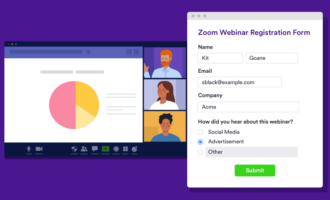If you conducted any business remotely in the past couple of years, you became familiar with video-conferencing software. Before the COVID-19 pandemic, these tools were mostly used for special circumstances, like geographically dispersed companies facilitating cross-country conversations. But once the pandemic hit, programs like BlueJeans and Webex became household names almost overnight.
Chief among these growing brands is the now-ubiquitous Zoom. In the last quarter of 2020, the company’s sales increased by 370 percent compared to the previous year. It’s a bit of macabre luck for the brand to have experienced such intense growth in such a short time due to a pandemic, but its unprecedented expansion is less a flash in the pan than a sign that remote work will remain the norm for the foreseeable future.
You can now expect to use Zoom consistently in all types of business contexts. So, if you haven’t yet, now is the perfect time to figure out which of the different Zoom plans best fits your organization and your budget. Let’s compare the two most common plans: Zoom Pro vs Business.
Zoom Pro vs Business: The differences
Though both Zoom plans offer essential video-conferencing functions, you should consider a few important differences.
Zoom Pro
As the first paid tier for Zoom, the Zoom Pro plan is great for freelancers or small teams with only a handful of employees. At a price point of $14.99 per month per license, Pro covers all the essentials in Zoom’s Basic plan with some great additions:
- 100-person meeting capacity
- Group meetings of up to 30 hours (compared to 40 minutes for the Basic plan)
- Social media streaming capability (including an integration with Facebook Live)
- Up to nine license assignees (those who can manage meetings to access these additional features)
- 5 GB of cloud storage for recordings
- In-meeting polling and co-host controls
- Ticketed and live-chat technical support
Zoom Business
Zoom Business expands on the Pro plan capabilities for $20.99 a month per license. These are some of the additional videoconferencing features that empower large businesses and enterprises:
- 300-person meeting capacity
- Personal admin portal to manage users and licensees in one central hub
- Ability to add your company’s branding to meetings and livestreams
- Learning tools interoperability (LTI) integration to connect to education tools like Blackboard or Canvas for classroom streaming
- Automatic transcription of meeting audio and cloud storage of transcripts
- Ability to designate in-meeting interpreters for multi-language streams
The right Zoom plan for you
When it comes down to the Zoom Pro vs Business decision, the central points you should consider are the size of your business, the ways you plan to use Zoom, and the financial commitment you’re willing to make.
To start, if your organization regularly conducts large-scale meetings, such as class lectures or webinars, Zoom Business is a necessity. As great as the Pro plan is, it’s not built to host bigger events (unless you’re interested in purchasing a special Large Meetings add-on, starting at another $50 a month, to increase the meeting participation limit to 1,000).
On top of that, the extended features of Zoom Business — like the in-meeting branding, admin portal, and LTI integrations — make this version essential for many. For instance, a remote mentoring service provider would depend heavily on these features to create a professional experience for their customers and clients. The admin portal allows for easy management of the many licensees (the individual mentors), while the LTI tools would let mentors integrate classroom-like tools and even a regular curriculum to their exercises.
If you don’t need features like LTI integration and admin portal, then the Pro plan should suit your needs. Freelancers and smaller companies that need to store meeting recordings or conduct longer sessions for group meetings can depend on Pro at a lower rate.
Jotform and Zoom: A powerful combination
After you make your Zoom Pro vs Business decision, you should consider what software to use in tandem with Zoom. One option is Jotform, which can enhance Zoom’s features through a simple but powerful integration.
Using Jotform’s event registration forms, you can invite participants to your events and even let them select certain time slots and set appointments. You can then sync this information directly with Zoom with the Jotform Zoom Scheduler to schedule and plan events or collect new registrants through your forms — from virtual happy hours to virtual conferences.
You can use one of Jotform’s payment integrations in your forms to collect fees for webinars, covering the entire registration process in one place. Other Jotform integrations include helpful apps like Google Calendar to manage schedules, HubSpot CRM to collect contact info, and Mailchimp to update email lists.
Your communication tools are a key part of your business, and Zoom has some of the best features on the market. Making the right choice between Zoom Pro vs Business can set you up for success in remote work.






























Send Comment: